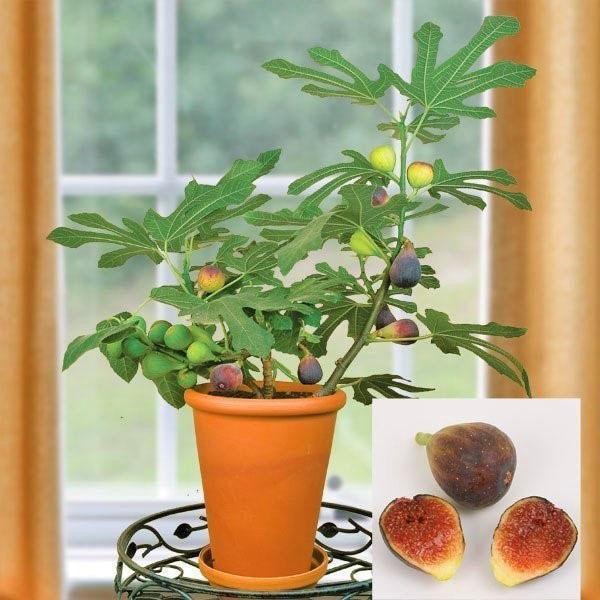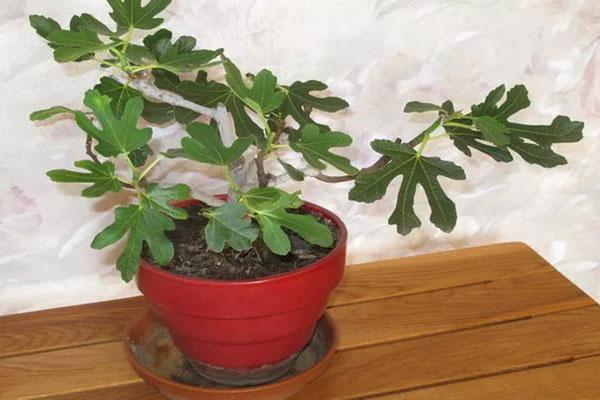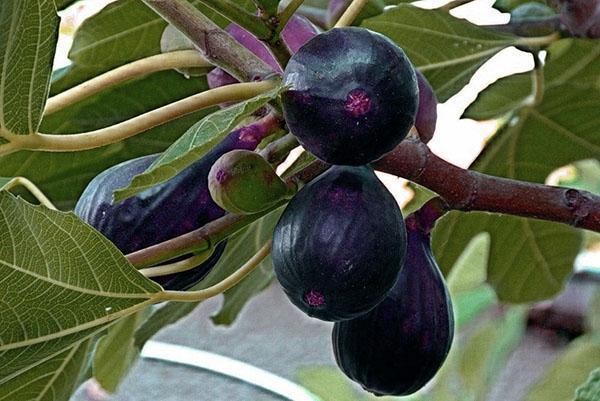Figs, growing at home - is it possible?
 Not everyone is lucky enough to live in the Mediterranean. The fig tree is also called a fig tree or figs - cultivation at home has been practiced in Europe since the 16th century. The benefits of fruits, the healing composition of the leaves does not depend on the place of cultivation. As a houseplant, with proper care, the fig looks decorative and bears fruit twice a year.
Not everyone is lucky enough to live in the Mediterranean. The fig tree is also called a fig tree or figs - cultivation at home has been practiced in Europe since the 16th century. The benefits of fruits, the healing composition of the leaves does not depend on the place of cultivation. As a houseplant, with proper care, the fig looks decorative and bears fruit twice a year.
Conditions for cultivating figs on the windowsill

A plant native to their subtropics must provide wintering. From November to January, a dormant period is created for the fig tree. It is arranged in a bright, cool place with a temperature below +15 degrees. The tree does not need additional lighting, feeding at this time.
If the tree does not fall asleep, watering is reduced to it so that the leaves fall off. Water the ground with slightly cool water at a temperature of 18 degrees.
 Water the plant sparingly so that the clod does not dry out. As the buds began to swell - light, and watering, and feeding are required. It is necessary to create conditions for fast vegetation. Two harvests per season can be harvested with good care of the figs at home. The first time the fig tree blooms in March, bears fruit in June. The next berries ripen from early August to late September. In summer, trees can be transferred into the ground, they will be comfortable there, but in the fall they will need a larger pot.
Water the plant sparingly so that the clod does not dry out. As the buds began to swell - light, and watering, and feeding are required. It is necessary to create conditions for fast vegetation. Two harvests per season can be harvested with good care of the figs at home. The first time the fig tree blooms in March, bears fruit in June. The next berries ripen from early August to late September. In summer, trees can be transferred into the ground, they will be comfortable there, but in the fall they will need a larger pot.
A sign of fruit ripeness is their softening and nectar release from the eyes. Ripening lasts 2-4 weeks.
Growing a fruiting fig tree on a windowsill
 How to grow figs at home? Several methods are used:
How to grow figs at home? Several methods are used:
- cuttings are prepared by begging for a twig from good friends;
- buy a seedling in a specialized store;
- use seed.
In any case, the first thing that is required is to pick up dishes and an earthen substrate. The soil is prepared with equal proportions of steamed, calcined ingredients:
- leaf humus;
- sod land;
- peat;
- river sand, wood ash.
Processed expanded clay is placed at the bottom of the bowl. A layer of sand is poured on top. It is a good idea to use sphagnum moss on the surface to regulate moisture.
Dishes for figs are selected at first small, but for 5 years, young plants are transplanted annually. You need to know that while the roots in the pot feel at ease, flowering is delayed. An adult tree needs 8 liters of substrate. The fig tree lives up to 30 years.
 Growing figs at home from cuttings is the most effective method, while maintaining parental properties. The stalk is taken only from a fruitful plant. The varieties are considered the most adapted to indoor growing conditions:
Growing figs at home from cuttings is the most effective method, while maintaining parental properties. The stalk is taken only from a fruitful plant. The varieties are considered the most adapted to indoor growing conditions:
- Shuisky;
- Dalmatic;
- White Adriatic;
- Sochi -7;
- Black Pearl;
- Kadata;
- Seedling Ogloblin.
The stalk is chosen with 3-4 buds, with the lower cut 2 cm below the eye, and the upper one 1 cm higher. On the rooted part, the bark must be scratched with longitudinal stripes to the cambium, this will accelerate root formation.Pour the ready-made substrate mixed with sphagnum into the glass, moisten and immerse the cutting along the second bud. Pre-treat the cutting with root or heteroauxin.
To form the roots, cover the planting from above with a PET bottle cap, put it on diffused light, use additional lighting up to 12 hours. We watch how the figs grow. After 2-3 weeks, the first leaves will appear, it is necessary to ventilate, accustoming the leaves to the air of the apartment, and spray with warm, settled water.
When the plant gets used to the surrounding air, it is carefully transferred into a liter pot with a substrate. Two weeks after transplanting, the fig tree is fed with nitrogen fertilizers or a composition for indoor plants.
 Fig seeds are small, the properties of the parent plant are not always inherited, not all germinate. But it happens, except from seeds, at home, there is nothing to breed figs from. The seeds are deepened into the soil by 2-3 cm, the soil is regularly moistened, the pots are covered from moisture evaporation, and after 2-4 weeks sprouts appear, which are allowed to grow, and are rooted in separate cups. Gradually changing the pots, the seedlings are grown for 4-5 years, before flowering. By this time, the young tree should already have large dishes, preferably a wooden box with a bucket of fertile soil. Time will tell whether indoor figs will bear fruit. But even without fruit, the tree is very impressive and will live up to 30 years.
Fig seeds are small, the properties of the parent plant are not always inherited, not all germinate. But it happens, except from seeds, at home, there is nothing to breed figs from. The seeds are deepened into the soil by 2-3 cm, the soil is regularly moistened, the pots are covered from moisture evaporation, and after 2-4 weeks sprouts appear, which are allowed to grow, and are rooted in separate cups. Gradually changing the pots, the seedlings are grown for 4-5 years, before flowering. By this time, the young tree should already have large dishes, preferably a wooden box with a bucket of fertile soil. Time will tell whether indoor figs will bear fruit. But even without fruit, the tree is very impressive and will live up to 30 years.
Top dressing for figs
 During the growing season, both a growing and an adult plant needs organic and mineral fertilizers... The compositions are alternated every 2 weeks. The fig tree gratefully accepts the mullein and fermented infusion of herbs - nettle, dandelion, biting midge. Once a season, you need to give the plant iron vitriol and a complex composition with trace elements. Figs need potassium-phosphorus fertilizers. They can be made independently from bags, in packaging for feeding seedlings of street plants.
During the growing season, both a growing and an adult plant needs organic and mineral fertilizers... The compositions are alternated every 2 weeks. The fig tree gratefully accepts the mullein and fermented infusion of herbs - nettle, dandelion, biting midge. Once a season, you need to give the plant iron vitriol and a complex composition with trace elements. Figs need potassium-phosphorus fertilizers. They can be made independently from bags, in packaging for feeding seedlings of street plants.
Pest and disease control
 Of insect pests, you need to protect the tree from the spider mite, or do 2 treatments in a week with the Actellik insecticide. It is difficult to cope with a pest without chemistry.
Of insect pests, you need to protect the tree from the spider mite, or do 2 treatments in a week with the Actellik insecticide. It is difficult to cope with a pest without chemistry.
There is only one common fungal disease in figs - coral spot. A sign of infection is the appearance of a reddish rash on the stem. All areas with affected shoots must be removed. Sections are treated with copper-containing preparations, and watering is carried out with a pink solution of potassium permanganate.